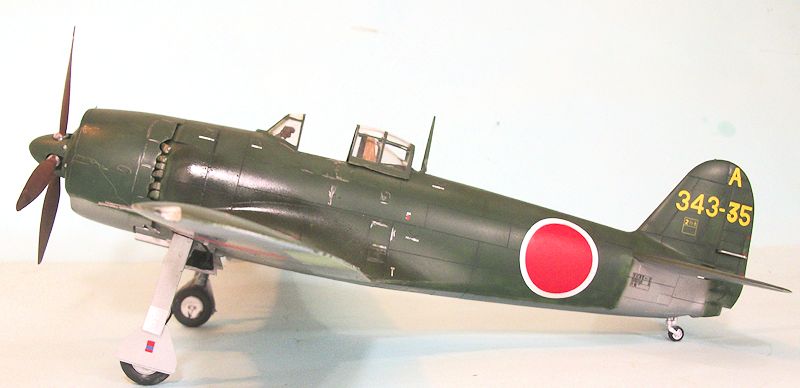
| KIT #: | 08883 |
| PRICE: | 4,000 yen from www.hlj.com |
| DECALS: | Two options |
| REVIEWER: | Tom Cleaver |
| NOTES: | New tool kit |

| HISTORY |
As historian
William Green put it, “It was characteristic of the improbabilities of the air
war in the Pacific theater that one of the finest land-based
fighters employed operationally by Japan was a naval
machine, and stranger yet, a fighter evolved from a
floatplane!”
Unfortunately, by the time it was introduced in early
1944, the N1K1 “Kyofu” (“Mighty Wind”)had no real role left and was produced
only in limited numbers.
By mid 1942, the
JNAF leadership understood they needed fighters with greater capability than the
Zero, particularly high-altitude capability.
As a back-up to the Mitsubish J2M “Raiden” project which
was experiencing delays, in November 1942 is was suggested to Kawanishi that
they might consider revising their floatplane for land-based operation, given
its performance.
Kawanishi accomplished something very unusual when they took their N1K1
and turned it into a land plane, which was accomplished only 9 months after the
project began.
Perhaps the most important thing that was done was to equip the
aircraft with a “combat flap, operated by electricity and
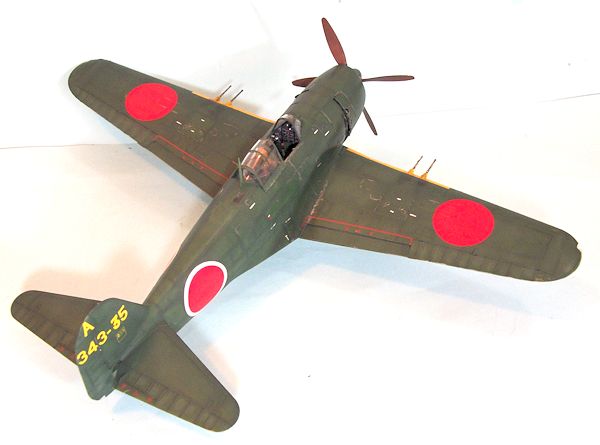 hydraulic
pressure, changing their angle automatically with changes in “G” value during
maneuvers and providing outstanding maneuverability.
Top speed was 362 mph and service ceiling was 39,700
feet.
353 “Shiden Model 11" (Shiden translating as “Violent Lightning”)
fighters were produced during 1944, and 112 in 1945 before production ended due
to bombing in June 1945.
hydraulic
pressure, changing their angle automatically with changes in “G” value during
maneuvers and providing outstanding maneuverability.
Top speed was 362 mph and service ceiling was 39,700
feet.
353 “Shiden Model 11" (Shiden translating as “Violent Lightning”)
fighters were produced during 1944, and 112 in 1945 before production ended due
to bombing in June 1945.
First introduced
into combat during the Marianas invasion in June 1944, the Shiden was a match
for its U.S. Navy opponents, with the F6F Hellcat being regarded as an easy kill
to a pilot with any experience.
Unfortunately, pilots with any experience were becoming
rare in the JNAF; coupled with the small number of Shidens committed, the
airplane had no effect on the outcome of the Marianas campaign.
The results were similar in the fighting over Formosa
and the Philippines invasion that fall, the next times the U.S. Navy confronted
the fighter, and it also participated in the Okinawa campaign; it was so good it
was one of the few Japanese airplanes not modified for “special attack.”
While the N1K1‑J
was at the time of its introduction in the spring of 1944 the outstanding
fighter aircraft used by the Imperial Japanese Navy and remained a potent
adversary throughout the rest of the war, the aircraft had a number of
shortcomings. Chief among these was the unreliability of the Homare 21 engine;
additionally, the wheel brakes were so bad the aircraft was often landed on
grass next to a paved runway to reduce the landing roll without brakes.
Kawanishi
undertook what was a near-complete redesign in mid-1943, to simplify the design
and solve the problems testing had revealed.
The wing was changed from the mid to the low position
with the most obvious visual difference from its predecessor bing that all four
20mm cannon were housed
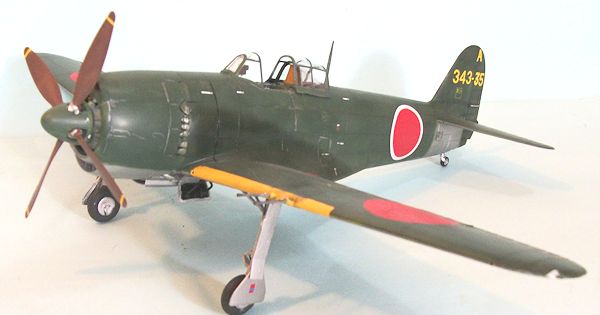 within the
wing. The airplane was also simplified for ease of production, using only 43,000
parts compared with the 66,000 of the N1K1‑J. The Homare 21 engine was modified,
but in the end proved no more reliable in the N1K2‑J than it had in the N1K1‑J.
The first prototype flew December 31, 1943, and it was accepted as the N1K2-J “Shiden
Model 21" also known as the Shiden-Kai for “modified.” Seven prototypes were
finished by June 1944, but they experienced a long series of teething troubles
that proved difficult to eliminate.
By the fall of 1944, the Shiden-Kai was behind schedule
and now confronted by the B-29 campaign, which was originally aimed at the
Japanese aircraft industry; sub-contractors were hit, which led to engine
shortages, steel forgings, aluminum stock and landing gear assemblies.
Only 60 Shiden-Kais were delivered in 1944, and only 294
produced in 1945.
Production was assigned to other factories, but the
numbers produced were negligible.
Had the war extended into 1946, JNAF plans called for
production of 9,240 Shiden-Kai fighters, which shows the aircraft’s importance.
Only 428 aircraft were produced by all manufacturers.
within the
wing. The airplane was also simplified for ease of production, using only 43,000
parts compared with the 66,000 of the N1K1‑J. The Homare 21 engine was modified,
but in the end proved no more reliable in the N1K2‑J than it had in the N1K1‑J.
The first prototype flew December 31, 1943, and it was accepted as the N1K2-J “Shiden
Model 21" also known as the Shiden-Kai for “modified.” Seven prototypes were
finished by June 1944, but they experienced a long series of teething troubles
that proved difficult to eliminate.
By the fall of 1944, the Shiden-Kai was behind schedule
and now confronted by the B-29 campaign, which was originally aimed at the
Japanese aircraft industry; sub-contractors were hit, which led to engine
shortages, steel forgings, aluminum stock and landing gear assemblies.
Only 60 Shiden-Kais were delivered in 1944, and only 294
produced in 1945.
Production was assigned to other factories, but the
numbers produced were negligible.
Had the war extended into 1946, JNAF plans called for
production of 9,240 Shiden-Kai fighters, which shows the aircraft’s importance.
Only 428 aircraft were produced by all manufacturers.
The Shiden-Kai
was without a doubt the finest Japanese Navy fighter of the war; its only
competitor for the title of best Japanese fighter of the war was the Nakajima
Ki.84 "Hayate."
It was fast and powerful with an armament of four 20mm cannon,
and in the hands of an average pilot was the equal of the P-51 Mustang, the F4U
Corsair and the F6f Hellcat.
The N1K2‑J shared
with the Ki.84 the ability to be an "ace‑maker." In June 1945, Warrant Officer
Kinsuke Muto ‑ a pilot of exceptional skill ‑ was jumped by 12 F6F Hellcats. He
succeeded in shooting down four before the others broke to escape back to their
carrier and he successfully landed his damaged Shiden‑Kai back at Yokosuka
airfield. Although the airplane was outstanding in fighter vs. fighter combat,
it was a disappointment in the one category that was really needed: high
altitude interception against the B‑29s, since it suffered poor climb above
22,000 feet due to loss of engine power.
"The Squadron of
Experts":
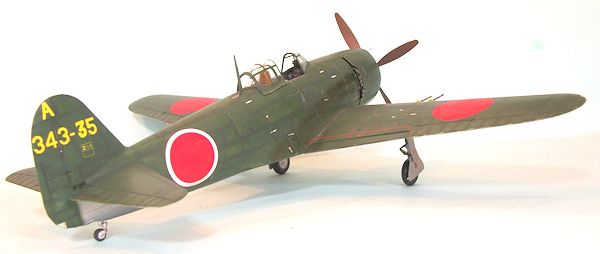 In March 1945, Captain
Minoru Genda, one of the outstanding Japanese Naval officers of the war (he was
the man who planned the Pearl Harbor attack) formed the 343rd
Air Group, the only JNAF organization to be completely mounted on the N1K2‑J
Shiden‑Kai. The unit was known as "The Squadron of Experts" because it had the
highest concentration of surviving experienced aces of any unit.
In March 1945, Captain
Minoru Genda, one of the outstanding Japanese Naval officers of the war (he was
the man who planned the Pearl Harbor attack) formed the 343rd
Air Group, the only JNAF organization to be completely mounted on the N1K2‑J
Shiden‑Kai. The unit was known as "The Squadron of Experts" because it had the
highest concentration of surviving experienced aces of any unit.
On March 19,
1945, the group experienced their baptism of fire when Task Force 58 struck the
Japanese naval base at Kure. Genda scrambled all three squadrons of the 343rd.
First contact came when VBF‑17 F6Fs from the "Bunker
Hill" ran into flights from 407th
and 701st squadrons. In a vicious
dogfight, six Hellcats and six N1K2‑Js went down.
The battles continued, with the 343rd
offering the only defense of the base. According to the group's records for that
day, the three squadrons claimed 53 Hellcats and Corsairs, and four Helldivers,
for a loss of 13. Chief Petty Officer Katsue Kato ‑ one of the greatest Japanese
aces of the war ‑ scored nine of this total. Given that at this stage of the
war, American pilots did not have the level of training their predecessors who
had fought in 1942‑44 had, and were in newly-arrived units that were also
experiencing their baptisms of fire, such an outcome against pilots as
experienced as those of the 343rd,
mounted in an airplane like the Shiden‑Kai, is not really that surprising. Had
the Japanese Navy been able to re‑equip with the Shiden‑Kai in the numbers
planned, the air battles over Japan in 1945 might have been very different,
though the final outcome of the war was no longer in doubt.
There were also not enough experienced pilots left to
“seed” such new units had the aircraft been available.
 One of the outstanding
pilots of the 343rd was Lt. Naoshi Kanno, the top‑scoring Naval Academy graduate
of the war. Kanno first saw combat in the N1K1‑J Shiden with the original 343rd
Air Group during the invasion of the Marianas in June 1944. Flying from the
island of Yap, he shot down several B‑24 Liberators using the head‑on attack
method. He was credited with 30 victories by
the summer of 1944. When the 343rd
Group was organized by Genda, Kanno was given command of the 301st
Squadron. In the battle of March 19, the 301st
initially took on Corsairs of VMF‑123.
Kanno was among the 13 shot down when he was hit by a
Corsair from VBF‑10, though he parachuted safely. Under his command, the 301st
had the highest losses of any unit in the 343rd,
though it also had the highest score. Kanno himself was credited with 13 more
victories while flying the N1K2‑J, before being killed attacking B‑24s over Yaku
Island on August 1, 1945.
One of the outstanding
pilots of the 343rd was Lt. Naoshi Kanno, the top‑scoring Naval Academy graduate
of the war. Kanno first saw combat in the N1K1‑J Shiden with the original 343rd
Air Group during the invasion of the Marianas in June 1944. Flying from the
island of Yap, he shot down several B‑24 Liberators using the head‑on attack
method. He was credited with 30 victories by
the summer of 1944. When the 343rd
Group was organized by Genda, Kanno was given command of the 301st
Squadron. In the battle of March 19, the 301st
initially took on Corsairs of VMF‑123.
Kanno was among the 13 shot down when he was hit by a
Corsair from VBF‑10, though he parachuted safely. Under his command, the 301st
had the highest losses of any unit in the 343rd,
though it also had the highest score. Kanno himself was credited with 13 more
victories while flying the N1K2‑J, before being killed attacking B‑24s over Yaku
Island on August 1, 1945.
| THE KIT |
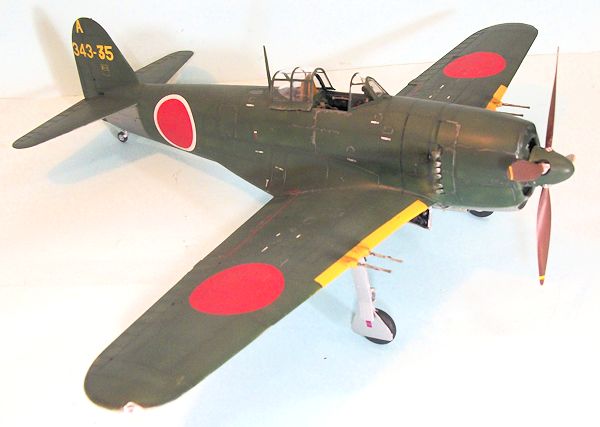 detail.
This kit is still in production and still the best kit of this airplane in 1/72
scale. In 1981, a 1/48 version was released that again was as far in advance of
the competition in this scale as the earlier kit had been ahead of anything else
in 1/72 when it was released. In fact, the 1981 release was so good that when
Hasegawa announced a new kit of this airplane in 2000, many modelers said "why?"
While the earlier model has raised panel lines, it still makes up into a very
acceptable model. The new 1/48 offering was as far in advance of other 1/48
models recently released as the earlier ones were in their day, and even
surpassed their excellent Ki.84 Hayate.
detail.
This kit is still in production and still the best kit of this airplane in 1/72
scale. In 1981, a 1/48 version was released that again was as far in advance of
the competition in this scale as the earlier kit had been ahead of anything else
in 1/72 when it was released. In fact, the 1981 release was so good that when
Hasegawa announced a new kit of this airplane in 2000, many modelers said "why?"
While the earlier model has raised panel lines, it still makes up into a very
acceptable model. The new 1/48 offering was as far in advance of other 1/48
models recently released as the earlier ones were in their day, and even
surpassed their excellent Ki.84 Hayate.
| CONSTRUCTION |
What can I say?
This kit maintains the tradition of the 1/48 kit in being one of the
best‑engineered kits released by Hasegawa, and is “Tamiya-like” in being both
highly detailed, yet easy to build. All the parts fit.
Assembly of the model other than waiting for paint to
dry took about six hours tops. I spent more time painting the details in the
cockpit and painting the model overall than I did in assembly. It would take a
modeler who was either illiterate, blind, or willfully opposed to following the
instructions to create a bad model from this kit.
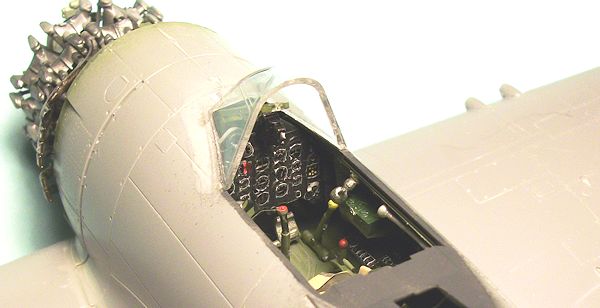 y
part of the N1K2‑Ja Shiden‑Kai restored by the Champlin Fighter Museum for the
National Air and Space Museum, plus detailed drawings of most major components.
Following these photos, I had no problem creating a very good‑looking cockpit.
I decided to position the
separate flaps in the raised position. As with most models with separated
control surfaces, these flaps are really designed to be displayed in the lowered
position, which they never were when the real airplane was parked. When I
attached the flaps in the raised position, they were not completely flush with
the lower wing surface as they should be. If I was doing this again, I would
cut out the area of the lower wing that is exposed by the lowered flaps, which
would allow the flaps to be properly positioned. Should you decide to build
this kit with the flaps raised, I suggest you do that before attaching them.
This cockpit needs no
resin replacement, being well‑detailed in its own right and setting a new
standard of what Hasegawa has done previously.
My only addition was making seat belts from lead foil
from a wine bottle (thank goodness I saved all those over the years, since you
can’t get any like that any more).
y
part of the N1K2‑Ja Shiden‑Kai restored by the Champlin Fighter Museum for the
National Air and Space Museum, plus detailed drawings of most major components.
Following these photos, I had no problem creating a very good‑looking cockpit.
I decided to position the
separate flaps in the raised position. As with most models with separated
control surfaces, these flaps are really designed to be displayed in the lowered
position, which they never were when the real airplane was parked. When I
attached the flaps in the raised position, they were not completely flush with
the lower wing surface as they should be. If I was doing this again, I would
cut out the area of the lower wing that is exposed by the lowered flaps, which
would allow the flaps to be properly positioned. Should you decide to build
this kit with the flaps raised, I suggest you do that before attaching them.
This cockpit needs no
resin replacement, being well‑detailed in its own right and setting a new
standard of what Hasegawa has done previously.
My only addition was making seat belts from lead foil
from a wine bottle (thank goodness I saved all those over the years, since you
can’t get any like that any more).
| COLORS & MARKINGS |
In pre-assembly,
I painted the cockpit according to Hasegawa’s instructions to create “Kawanishi
cockpit color,” mixing Tamiya “Japanese Cockpit Color,” which is the Mitsubishi
light green-gray color, with “Nakajima Cockpit Color,” for which I substituted
Tamiya “NATO Green,” which is a close match.
This looked right according to the color photos in the
Aero Detail book.
 w
ID stripes on the leading edge of the wing, then masked off all these areas.
I then painted the rest of the lower surfaces with
Alclad “Dural Aluminum.
I then preshaded the upper surfaces with flat black
along the panel lines‑shading.
I painted the upper surfaces according to Hasegawa’s
mixing instructions, using Tamiya “Mitsubishi Green” and Tamiya “Flat Blue” in a
90/10 mixture.
This color also comported with the colors in the Aero Detail
book.
After application of the main coat, I lightened the paint twice, adding
in Gunze “Light Gull Grey,” and going over the upper area to “age” the paint.
The prop blades were painted with Tamiya “Red Brown.”
I then gave the upper surfaces a coat of Future.
w
ID stripes on the leading edge of the wing, then masked off all these areas.
I then painted the rest of the lower surfaces with
Alclad “Dural Aluminum.
I then preshaded the upper surfaces with flat black
along the panel lines‑shading.
I painted the upper surfaces according to Hasegawa’s
mixing instructions, using Tamiya “Mitsubishi Green” and Tamiya “Flat Blue” in a
90/10 mixture.
This color also comported with the colors in the Aero Detail
book.
After application of the main coat, I lightened the paint twice, adding
in Gunze “Light Gull Grey,” and going over the upper area to “age” the paint.
The prop blades were painted with Tamiya “Red Brown.”
I then gave the upper surfaces a coat of Future.
| CONCLUSIONS |
Thanks to HobbyLink
Japan for the review kit.
Get yours at
If you would like your product reviewed fairly and fairly quickly, please contact the editor or see other details in the Note to Contributors.